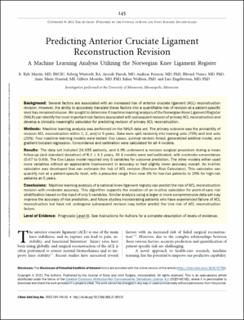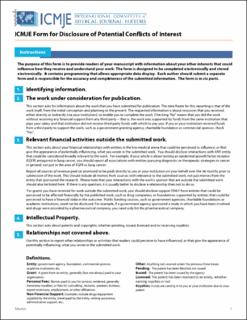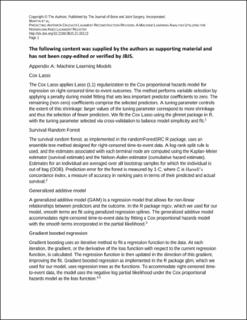| dc.contributor.author | Martin, Richard Kyle | |
| dc.contributor.author | Wastvedt, Solvejg | |
| dc.contributor.author | Pareek, Ayoosh | |
| dc.contributor.author | Persson, Andreas | |
| dc.contributor.author | Visnes, Håvard | |
| dc.contributor.author | Fenstad, Anne Marie | |
| dc.contributor.author | Moatshe, Gilbert | |
| dc.contributor.author | Wolfson, Julian | |
| dc.contributor.author | Engebretsen, Lars | |
| dc.date.accessioned | 2022-03-21T22:49:25Z | |
| dc.date.available | 2022-03-21T22:49:25Z | |
| dc.date.created | 2021-12-10T08:59:53Z | |
| dc.date.issued | 2022 | |
| dc.identifier.citation | The Journal of Bone & Joint Surgery. 2021, 104(2), Side 145–153. | en_US |
| dc.identifier.issn | 0021-9355 | |
| dc.identifier.uri | https://hdl.handle.net/11250/2986648 | |
| dc.description | This is an open-access article distributed under the terms of the Creative Commons Attribution-Non Commercial-No Derivatives License 4.0 (CCBY-NC-ND), where it is permissible to download and share the work provided it is properly cited. The work cannot be changed in any way or used commercially without permission from the journal. | en_US |
| dc.description.abstract | Background: Several factors are associated with an increased risk of anterior cruciate ligament (ACL) reconstruction revision. However, the ability to accurately translate these factors into a quantifiable risk of revision at a patient-specific level has remained elusive. We sought to determine if machine learning analysis of the Norwegian Knee Ligament Register (NKLR) can identify the most important risk factors associated with subsequent revision of primary ACL reconstruction and develop a clinically meaningful calculator for predicting revision of primary ACL reconstruction.
Methods: Machine learning analysis was performed on the NKLR data set. The primary outcome was the probability of revision ACL reconstruction within 1, 2, and/or 5 years. Data were split randomly into training sets (75%) and test sets (25%). Four machine learning models were tested: Cox Lasso, survival random forest, generalized additive model, and gradient boosted regression. Concordance and calibration were calculated for all 4 models.
Results: The data set included 24,935 patients, and 4.9% underwent a revision surgical procedure during a mean follow-up (and standard deviation) of 8.1 ± 4.1 years. All 4 models were well-calibrated, with moderate concordance (0.67 to 0.69). The Cox Lasso model required only 5 variables for outcome prediction. The other models either used more variables without an appreciable improvement in accuracy or had slightly lower accuracy overall. An in-clinic calculator was developed that can estimate the risk of ACL revision (Revision Risk Calculator). This calculator can quantify risk at a patient-specific level, with a plausible range from near 0% for low-risk patients to 20% for high-risk patients at 5 years.
Conclusions: Machine learning analysis of a national knee ligament registry can predict the risk of ACL reconstruction revision with moderate accuracy. This algorithm supports the creation of an in-clinic calculator for point-of-care risk stratification based on the input of only 5 variables. Similar analysis using a larger or more comprehensive data set may improve the accuracy of risk prediction, and future studies incorporating patients who have experienced failure of ACL reconstruction but have not undergone subsequent revision may better predict the true risk of ACL reconstruction failure.
Level of Evidence: Prognostic Level III. See Instructions for Authors for a complete description of levels of evidence. | en_US |
| dc.language.iso | eng | en_US |
| dc.subject | ACL | en_US |
| dc.subject | anterior cruciate ligament | en_US |
| dc.subject | machine learning analysis | en_US |
| dc.subject | reconstruction | en_US |
| dc.title | Predicting anterior cruciate ligament reconstruction revision: A machine learning analysis utilizing the Norwegian knee ligament register | en_US |
| dc.type | Peer reviewed | en_US |
| dc.type | Journal article | en_US |
| dc.description.version | publishedVersion | en_US |
| dc.rights.holder | © 2021 The Authors | en_US |
| dc.source.pagenumber | 145–153 | en_US |
| dc.source.volume | 104 | en_US |
| dc.source.journal | The Journal of Bone & Joint Surgery | en_US |
| dc.source.issue | 2 | en_US |
| dc.identifier.doi | 10.2106/JBJS.21.00113 | |
| dc.identifier.cristin | 1966878 | |
| dc.description.localcode | Institutt for idrettsmedisinske fag / Department of Sports Medicine | en_US |
| cristin.ispublished | true | |
| cristin.fulltext | original | |
| cristin.qualitycode | 2 | |


